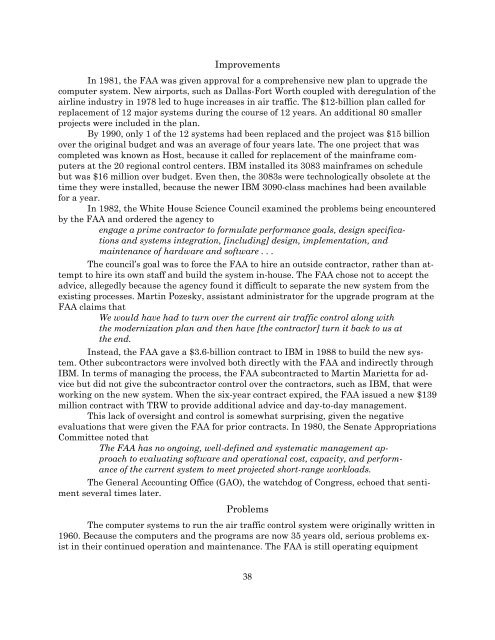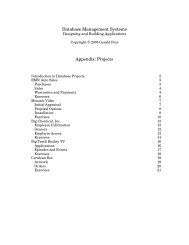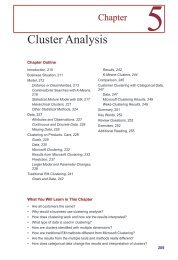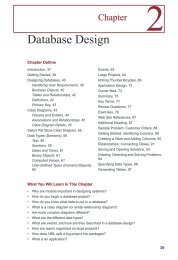Revision History - Jerry Post
Revision History - Jerry Post
Revision History - Jerry Post
Create successful ePaper yourself
Turn your PDF publications into a flip-book with our unique Google optimized e-Paper software.
Improvements<br />
In 1981, the FAA was given approval for a comprehensive new plan to upgrade the<br />
computer system. New airports, such as Dallas-Fort Worth coupled with deregulation of the<br />
airline industry in 1978 led to huge increases in air traffic. The $12-billion plan called for<br />
replacement of 12 major systems during the course of 12 years. An additional 80 smaller<br />
projects were included in the plan.<br />
By 1990, only 1 of the 12 systems had been replaced and the project was $15 billion<br />
over the original budget and was an average of four years late. The one project that was<br />
completed was known as Host, because it called for replacement of the mainframe computers<br />
at the 20 regional control centers. IBM installed its 3083 mainframes on schedule<br />
but was $16 million over budget. Even then, the 3083s were technologically obsolete at the<br />
time they were installed, because the newer IBM 3090-class machines had been available<br />
for a year.<br />
In 1982, the White House Science Council examined the problems being encountered<br />
by the FAA and ordered the agency to<br />
engage a prime contractor to formulate performance goals, design specifications<br />
and systems integration, [including] design, implementation, and<br />
maintenance of hardware and software . . .<br />
The council’s goal was to force the FAA to hire an outside contractor, rather than attempt<br />
to hire its own staff and build the system in-house. The FAA chose not to accept the<br />
advice, allegedly because the agency found it difficult to separate the new system from the<br />
existing processes. Martin Pozesky, assistant administrator for the upgrade program at the<br />
FAA claims that<br />
We would have had to turn over the current air traffic control along with<br />
the modernization plan and then have [the contractor] turn it back to us at<br />
the end.<br />
Instead, the FAA gave a $3.6-billion contract to IBM in 1988 to build the new system.<br />
Other subcontractors were involved both directly with the FAA and indirectly through<br />
IBM. In terms of managing the process, the FAA subcontracted to Martin Marietta for advice<br />
but did not give the subcontractor control over the contractors, such as IBM, that were<br />
working on the new system. When the six-year contract expired, the FAA issued a new $139<br />
million contract with TRW to provide additional advice and day-to-day management.<br />
This lack of oversight and control is somewhat surprising, given the negative<br />
evaluations that were given the FAA for prior contracts. In 1980, the Senate Appropriations<br />
Committee noted that<br />
The FAA has no ongoing, well-defined and systematic management approach<br />
to evaluating software and operational cost, capacity, and performance<br />
of the current system to meet projected short-range workloads.<br />
The General Accounting Office (GAO), the watchdog of Congress, echoed that sentiment<br />
several times later.<br />
Problems<br />
The computer systems to run the air traffic control system were originally written in<br />
1960. Because the computers and the programs are now 35 years old, serious problems exist<br />
in their continued operation and maintenance. The FAA is still operating equipment<br />
38







